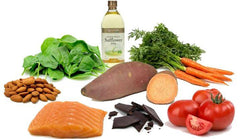Top Foods You Must Have For Beautiful Skin
Posted on 21 January 2016 by Ning W
Share this post

When nutritionists say, “You are what you eat,” what they’re saying is that if you make smarter choices when it comes to meals and snacks, not only you will feel healthier and have more energy, but your skin will also have a glorious glow. And while many of us don’t think beyond our chocolate cravings as the reason why we tend to break out from time to time, food plays a big role in the overall appearance of our skin. “There’s a growing body of research showing that diet really does affect your complexion,” Dr. Jessica Wu, a dermatologist in Los Angeles and author of “Feed Your Face” told Prevention magazine. “What you eat can affect your hormone balance, cause acne, and create or lessen inflammation, which is associated with skin aging.” And while the serums and lotions we apply to our skin can go deep beneath the surface of skin to improve how your skin looks and feels – when outer applications meet the beneficial nutrients going to work from the inside, that’s when the magic happens.
Omega-3s
Fish like tuna and salmon and nuts – especially walnuts – are good sources or Omega-3 fatty acids, which help make skin cells strong. Omega-3 fatty acids create a protective membrane around skin cells, supporting the skin’s structure so it is less likely to sag or wrinkle. Not only that, omega-3s contain the anti-inflammatory DHA, an important part of both brain and skin health. “Inflammation is now known as the root cause of acne,” according to Dr. Wu. Keeping inflammation in check can help reduce breakouts so skin stays clear.
Collagen boosters
There are two main proteins that keep skin looking fresh, young, vibrant and dewy – collagen and elastin. Found beneath the epidermis, collagen is the foundation of connective tissue that supports the skin’s structure, so it makes skin look firm and prevents it from sagging. As we age, however, our body produces less of it and outside influences help break existing collagen down, causing skin to become thinner, lose fullness and develop wrinkles. The sun, pollution, free radicals and smoke are also responsible for disintegrating collagen.  Since skin is made up of about 75 percent collagen, protecting it – and helping to encourage it to regenerate – are important steps to maintaining our youth. While many skin care products contain both proteins – or other ingredients that help trigger the regeneration of these proteins deep beneath the skin’s surface – taking in foods that boost the production of collagen and elastin can also make skin look healthier. “Stimulating collagen with proper lifestyle choices helps the skin maintain its strength, resiliency and volume,” according to Madison, Wisconsin-based plastic surgeon Dr. Richard C. Parfitt.
Since skin is made up of about 75 percent collagen, protecting it – and helping to encourage it to regenerate – are important steps to maintaining our youth. While many skin care products contain both proteins – or other ingredients that help trigger the regeneration of these proteins deep beneath the skin’s surface – taking in foods that boost the production of collagen and elastin can also make skin look healthier. “Stimulating collagen with proper lifestyle choices helps the skin maintain its strength, resiliency and volume,” according to Madison, Wisconsin-based plastic surgeon Dr. Richard C. Parfitt.
Some top collagen boosters:
• Dark green veggies. Kale, spinach and collards are all packed with vitamin C, one of the most skin-friendly vitamins found in food. “Vitamin C has antioxidizing properties that stabilize the messenger enzymes that break collagen down. It also protects against free radicals to prevent weak collagen,” according to Dr. Dimitry Palceski, an Orlando-based dermatologist. • Garlic. Garlic is an excellent source of sulfur, which is necessary to help hold collagen fibers together. Garlic also contains two nutrients – lipoic acid and taurine – that help rebuild damaged collagen, improving the look of skin. • Citrus. Lemons, oranges, limes and grapefruits not only have vitamin C, but they also can help two key amino acids, lysine and proline, convert to collagen. That means the more citrus you eat, the more collagen you’ll have. • Soy. Soy contains the plant hormone genistein, which helps encourage the production of collagen while blocking enzymes that speed aging. To protect existing collagen and elastin, eat a rainbow of colors – red raspberries, blueberries, lemons, kale, orange bell peppers, tomatoes, etc. – so you have plenty of antioxidants on hand to fight free radicals. Free radicals are particularly drawn to the skin proteins collagen and elastin, so if you can snuff them out before they can do damage, you’ll stay younger looking so much longer.
Natural Protection from the Sun
We all know that tomatoes can help protect against some cancers while boosting the health of your heart and your eyes thanks to the lycopene that gives the flavor-packed fruit its red color, but it turns out lycopene can also help protect your skin from the damaging rays of the sun. According to a 2008 study from the United Kingdom, those who ate a diet that included five tablespoons of tomato paste coupled with a tablespoon of olive oil a day for 12 weeks were 33 percent less likely to be protected from sunburn compared to the control group, which consumed only olive oil. Because sun exposure has the most negative impact on the youthful look of skin, any extra protection is good news, especially so for those who live at the beach and are regularly exposed to more powerful sun’s rays. Lycopene – which is at its most potent when cooked – protects from sunburn because it elevates our skin’s natural SPF. (Of course that’s not to say eating tomato paste gives license to skip the sunscreen. A good sunscreen will protect your skin from not only burns, but the UV rays associated with aging.)
Encourage New Skin Cell Production
Beta-carotene – found in orange veggies like acorn squash, pumpkin and sweet potatoes – is converted into vitamin A by our bodies, ensuring the growth of new skin cells. Vitamin A also acts as an antioxidant, protecting not only existing cells, but also the new growth beneath the surface.  Your anti-aging shopping list: If you’re shopping for skin health, look for fish rich in Omega-3 fatty acids (salmon and tuna are best); foods rich in vitamin A to encourage the growth of new skins cells (pumpkin, sweet potatoes and other orange foods); and collagen-boosting foods (citrus, soy, dark green veggies, celery and cucumber).
Your anti-aging shopping list: If you’re shopping for skin health, look for fish rich in Omega-3 fatty acids (salmon and tuna are best); foods rich in vitamin A to encourage the growth of new skins cells (pumpkin, sweet potatoes and other orange foods); and collagen-boosting foods (citrus, soy, dark green veggies, celery and cucumber).
REFERENCES: https://www.prevention.com/beauty/natural-beauty/25-best-foods-your-skin



0 comments